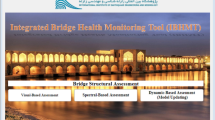Abstract
One challenge to the wider adoption of structural health monitoring (SHM) in bridges is demonstrating the value added by the SHM system in maintenance and operation of the bridge to the owner. One way to do this is to use SHM systems and data to provide more accurate, frequent, and realistic live load ratings of a bridge, since the widely accepted load rating is the closest thing a bridge owner has today, to a “health” index of the structure. To address this need, a method has been developed that uses data from SHM systems in combination with conventional load rating equations, to compute continuous rating factors throughout the life of a bridge. The SHM-based ratings take into account slowly varying changes due to thermal effects and deterioration, as well as the actual in-service response due to live loads. The approach is demonstrated on Delaware’s 533-m cable-stayed Indian River Inlet Bridge. Continuous rating factors are computed and reported for periods of time and are compared to the AASHTO LRFR rating factors for the bridge. These rating factors are being used by the Delaware Department of Transportation to both assess the condition of the IRIB and to manage this important structure.












Similar content being viewed by others
References
Alampalli S, Ettouney MM (2014) Structural health monitoring. In: Zoghi M (ed) International handbook on FRP composites in civil engineering, pp 559–572
Liu T, Yang B, Zhang QL (2017) Health monitoring system developed for Tianjin 117 high-rise building. J Aerosp Eng 30(2):B4016004
Smarsly K, Hartmann D, Law KH (2013) An integrated monitoring system for life-cycle management of wind turbines. Smart Struct Syst 12:209–233
De Stefano A, Matta E, Clemente P (2016) Structural health monitoring of historical heritage in Italy: some relevant experiences. J Civ Struct Health Monit 6:83–106
Bao CX, Hao H, Li ZX (2013) Vibration-based structural health monitoring of offshore pipelines: numerical and experimental study. Struct Control Health Monit 20:769–788
Betti RM, Sloane MJ, Khazem D, Gatti C (2016) Monitoring the structural health of main cables of suspension bridges. J Civ Struct Health Monit 6:355–363
Zhou GD, Yi TH, Chen B (2017) Innovative design of a health monitoring system and its implementation in a complicated long-span arch bridge. J Aerosp Eng 30:B4016006
Brownjohn JM, Kripakaran WP, Harvey B, Kromanis R, Jones P, Huseynov F (2016) Structural health monitoring of short to medium span bridges in the United Kingdom. Struct Monit Maint 3:259–276
Gokce HB, Gul M, Catbas FN (2012) Implementation of structural health monitoring for movable bridges. Transp Res Rec 2313(1):124–133
Kim YJ, Murison E, Mufti A (2010) Structural health monitoring: a Canadian perspective. Proc Inst Civ Eng-Civ Eng 163:185–191
Li HN, Ren L, Jia ZG, Yi TH, Li DS (2016) State-of-the-art in structural health monitoring of large and complex civil infrastructures. J Civ Struct Health Monit 6:3–16
Ni YQ, Xia YX (2016) Strain-based condition assessment of a suspension bridge instrumented with structural health monitoring system. Int J Struct Stab Dyn 16:1640027
Wang H, Tao TY, Li AQ, Zhang YF (2016) Structural health monitoring system for Sutong cable-stayed bridge. Smart Struct Syst 18:317–334
Yarnold MT, Moon FL (2015) Temperature-based structural health monitoring baseline for long-span bridges. Eng Struct 86:157–167
Doebling SW, Farrar CR, Prime MB, Shevitz DW (1996) Damage identification and health monitoring of structural and mechanical systems from changes in their vibration characteristics: a literature review. Los Alomos National Laboratory, New Mexico
Sohn H, Farrar CR, Hemez FM, Shunk DD, Stimemates DW, Nadler BR (2003) A review of structural health monitoring literature: 1996–2001, Los Alamos National Laboratory Report, LA-13976-MS
Carden EP, Fanning P (2004) Vibration based condition monitoring: a review. Struct Health Monit 3:355–377
Das S, Saha P, Patro SK (2016) Vibration-based damage detection techniques used for health monitoring of structures: a review. J Civ Struct Health Monit 6:447–507
Mesquita E, Antunes P, Coelho F, Andre P, Andre A, Varum H (2016) Global overview on advances in structural health monitoring platforms. J Civ Struct Health Monit 6:461–475
Li H, Ou JP (2016) The state of the art in structural health monitoring of cable-stayed bridges. J Civ Struct Health Monit 6:43–67
Li J, Hao H (2016) A review of recent research advances on structural health monitoring in Western Australia. Struct Monit Maint 3:33–49
Seo J, Hu JW, Lee J (2016) Summary review of structural health monitoring applications for highway bridges. J Perform Constr Facil 30:04015072
Seo J, Phares B, Lu P, Wipf T, Dahlberg J (2013) Bridge rating protocol using ambient trucks through structural health monitoring system. Eng Struct 46:569–580
AASHTO (2001) Manual for condition evaluation of bridges. American Association for State Highway and transportation Officials, Washington, DC
Deng Y, Phares B (2013) Automated bridge load rating determination utilizing strain response due to ambient traffic trucks. Eng Struct 117:101–117
AASHTO (2016) Manual for Bridge Evaluation. American Association of State Highway and Transportation Officials, Washington, DC
URS Corporation, “Load Rating Analysis: Structural Load Rating Criteria,” October 2009. Available: https://www.in.gov/indot/div/SR912ClineAve/. [Accessed 29 May 2018]
Lai LY (2013) “Thermal effects on load rating of reinforced concrete arch bridges,” in Structures Congress 2013. Pittsburgh, PA
Al-Khateeb HT (2016) Bridge evaluation utilizing structural health monitoring data, PhD Dissertation, University of Delaware, Newark, Delaware, 2016
Shenton HW III, Al-Khateeb HT, Chajes MJ, Wenczel G (2017) Indian River Inlet Bridge (Part A): description of the bridge and the structural health monitoring system. Bridge Struct 13(1):3–13
Author information
Authors and Affiliations
Corresponding author
Additional information
Publisher's Note
Springer Nature remains neutral with regard to jurisdictional claims in published maps and institutional affiliations.
Rights and permissions
About this article
Cite this article
Al-Khateeb, H.T., Shenton, H.W. & Chajes, M.J. Computing continuous load rating factors for bridges using structural health monitoring data. J Civil Struct Health Monit 8, 721–735 (2018). https://doi.org/10.1007/s13349-018-0313-4
Received:
Accepted:
Published:
Issue Date:
DOI: https://doi.org/10.1007/s13349-018-0313-4




